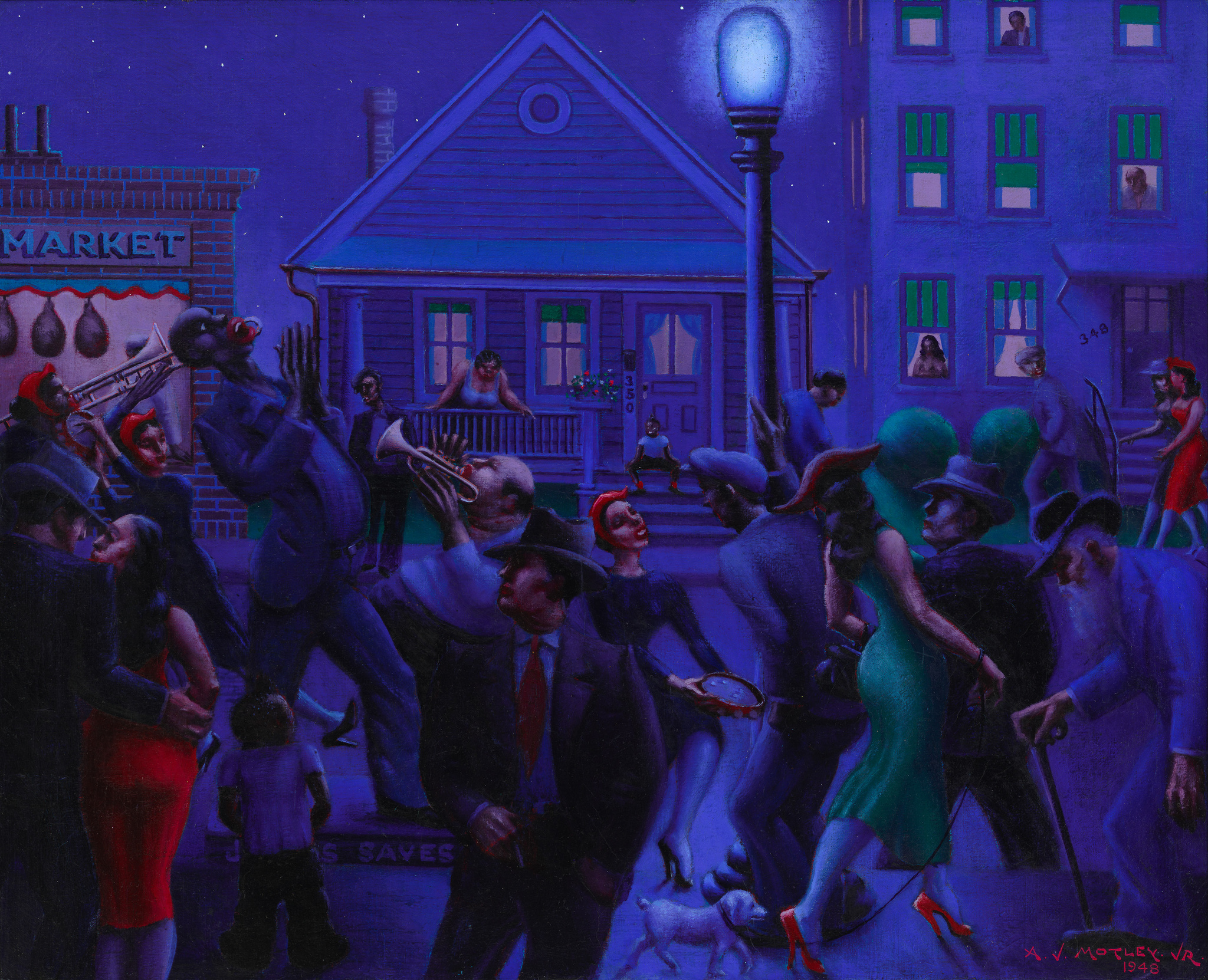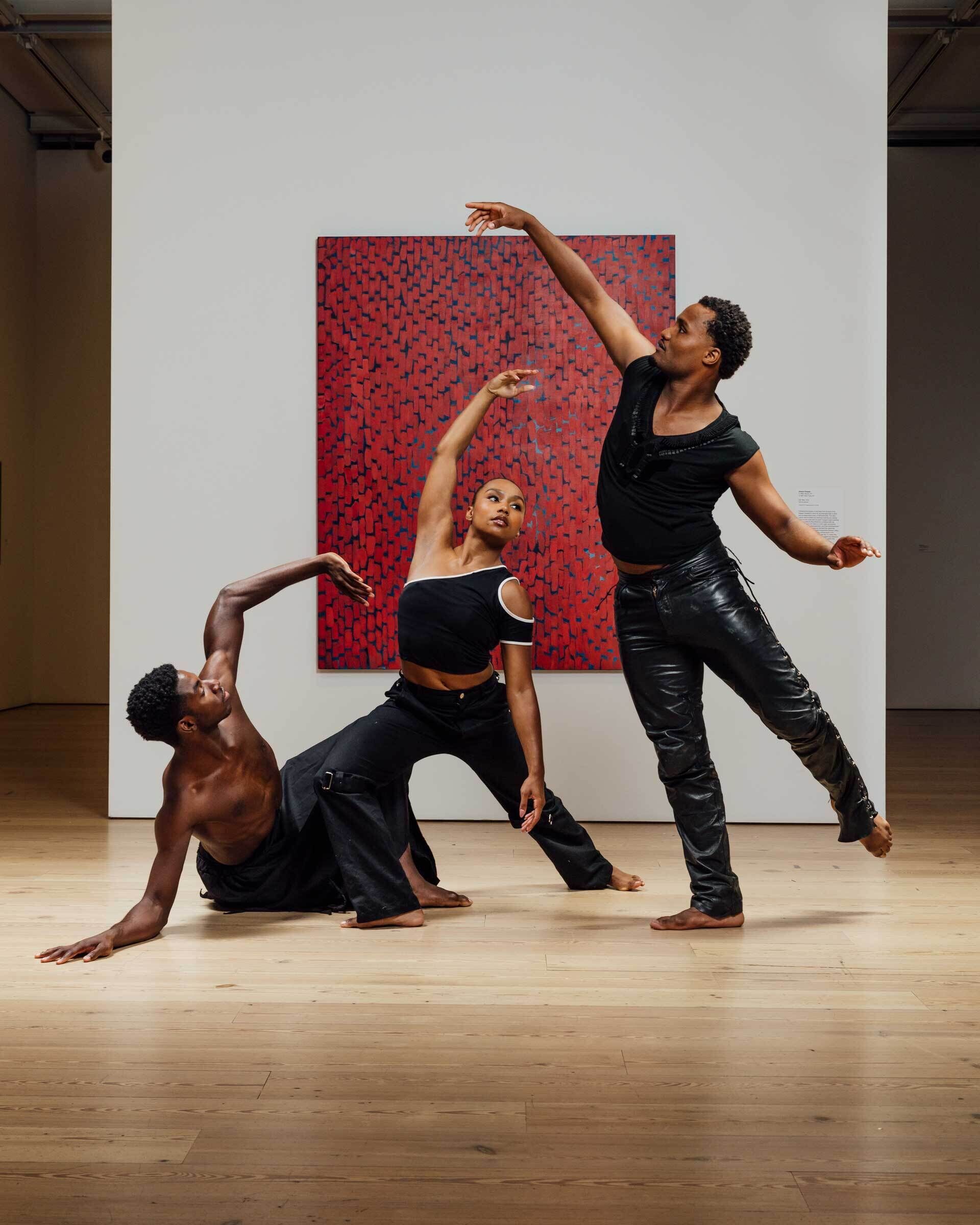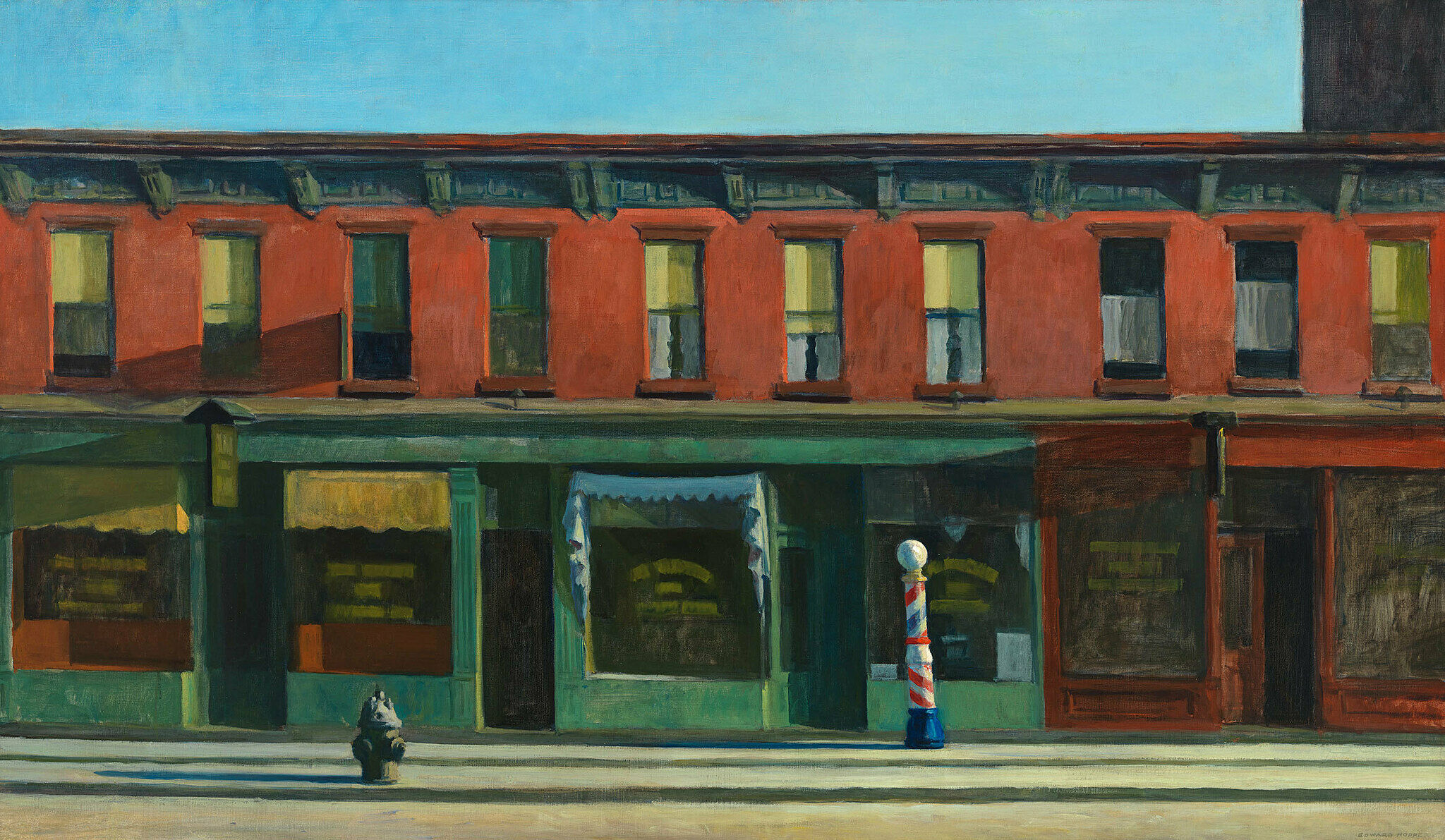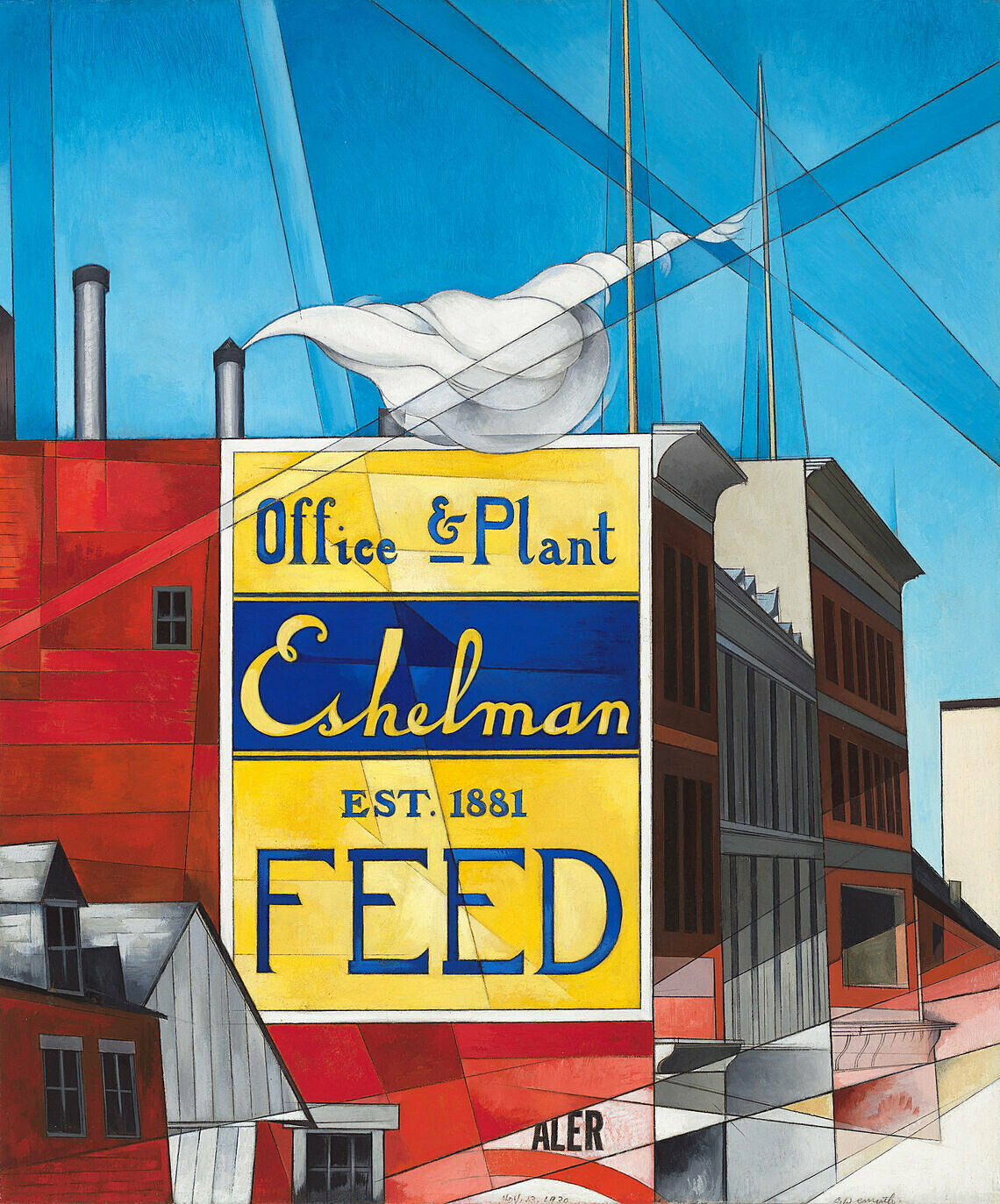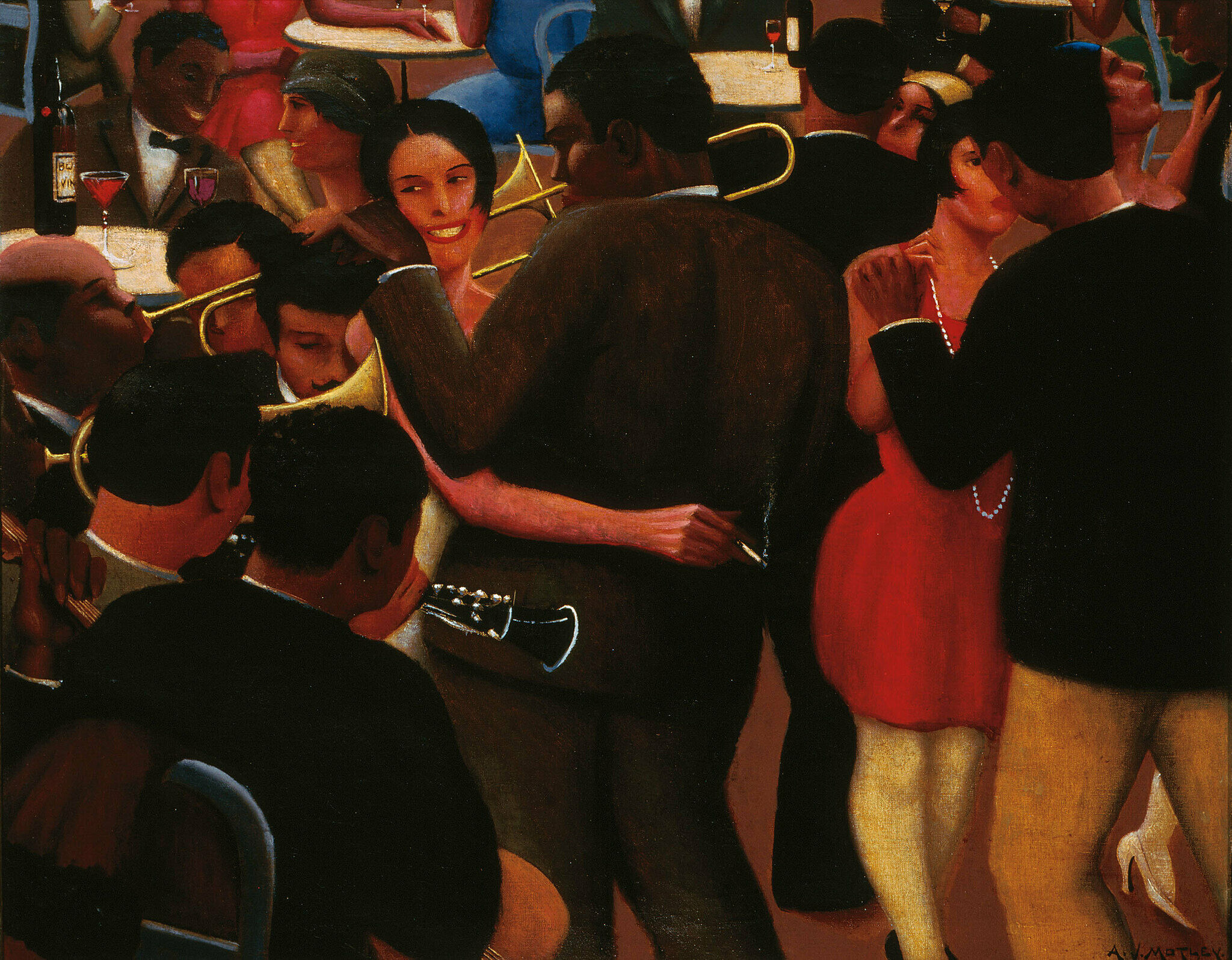On view
Floor 7
Date
1948
Classification
Paintings
Medium
Oil on linen
Dimensions
Overall: 32 × 39 7/16in. (81.3 × 100.2 cm)
Accession number
2016.15
Credit line
Whitney Museum of American Art, New York; purchase, Josephine N. Hopper Bequest, by exchange
Rights and reproductions
© Valerie Gerrard Browne
Visual description
Gettin' Religion by Archibald Motley, Jr. is a horizontal oil painting on canvas, measuring about 3 feet wide by 2.5 feet high. The work has a vividly blue, dark palette and depicts a crowded, lively night scene with many figures of varied skin tones walking, standing, proselytizing, playing music, and conversing. The appearance of the paint on the surface is smooth and glossy.
In the background of the work, three buildings appear in front of a starry night sky: a market storefront, with meat hanging in the window; a home with stairs leading up to a front porch, where a woman and a child watch the activity; and an apartment building with many residents peering out the windows. The entire scene is illuminated by starlight and a bluish light emanating from a streetlamp, casting a distinctive glow.
In the foreground is a group of Black performers playing brass instruments and tambourines, surrounded by people of great variety walking, spectating, and speaking with each other. A smartly dressed couple in the bottom left stare into each other’s eyes. A child stands with their back to the viewer and hands in pocket. A solitary man in profile smokes a cigarette in the near foreground. A woman with long wavy hair, wearing a green dress and strikingly red stilettos walks a small white dog past a stooped, elderly, bearded man with a cane in the bottom right, among other figures. The crowd is interspersed and figures overlap, resulting in a dynamic, vibrant depiction of a night scene.
A central focal point of the foreground scene is a tall Black man, so tall as to be out of scale with the rest of the figures, who has exaggerated features including unnaturally red lips, and stands on a pedestal that reads “Jesus Saves.” This caricature draws on the racist stereotype of the minstrel, and Motley gave no straightforward reason for its inclusion. The artist’s ancestry included Black, Indigenous, and European heritage, and he grappled with his racial identity throughout his life. He may have chosen to portray the stereotype to skewer assumptions about urban Black life and communities, by creating a contrast with the varied, more realistic, figures surrounding the preacher.
A participant in the Great Migration of many Black Americans from the South to urban centers in the North, Motley’s family moved from New Orleans to Chicago when he was a child. He was especially intrigued by the jazz scene, and Black neighborhoods like Bronzeville in Chicago, which is the inspiration for this scene and many of his other works. In Getting’ Religion, Motley has captured a portrait of what scholar Davarian L. Baldwin has called “the full gamut of what I consider to be Black democratic possibility, from the sacred to the profane.”
Audio
-
descripción verbal: Archibald John Motley Jr., Entendiendo la religión, 1948
In “Untitled” (America) (Spanish)
0:00
Descripción verbal: Archibald John Motley Jr., Entendiendo la religión, 1948
0:00
Narrador: Entendiendo la religión, realizada en 1948, es una pintura al óleo horizontal sobre lienzo. La pintura se exhibe en la sección Música negra de la exposición. Mide poco más de 60 cm de alto y 90 cm de ancho. Esta escena nocturna muestra un animado grupo de personas de diferentes tonos de piel moviéndose por una acera. Algunas tocan música o pasean, mientras otras observan desde las ventanas y un porche al otro lado de la calle. Algunas de las personas pueden identificarse como negras, pero no todas. Al fondo, de izquierda a derecha, hay un edificio de ladrillo con el letrero "market", una casa y un edificio de apartamentos, extendiéndose de un extremo del cuadro al otro. Toda la pintura está bañada por un color azul intenso, que combina con el azul vivo del cielo nocturno que se ve sobre los tejados de los edificios, salpicado de pequeñas estrellas.
Justo a la derecha del centro, una prominente farola alcanza el borde superior de la pintura y proyecta un resplandor blanco azulado sobre los contornos de los cuerpos, los rostros y las superficies de la calle y los edificios. Aunque no hay señales de tráfico que lo hagan inmediatamente evidente, la pintura está ambientada en Bronzeville, Chicago. Motley fue uno de los primeros artistas negros en asistir a la Escuela del Instituto de Arte de Chicago. Un trozo de césped, una jardinera y dos setos redondos dan un aire de barrio a la escena. El género, la edad, y los roles de las personas, así como la época a la que pertenecen, se sugieren claramente por su vestimenta: los hombres llevan sombreros y trajes, las mujeres vestidos por la rodilla con tacones altos y los niños camisetas y pantalones lisos. Los rasgos de las personas del fondo son indefinidos, pero expresivos.
Un punto focal de la escena en primer plano es un hombre afroamericano alto, tan alto que desentona con el resto de las figuras, con rasgos exagerados, como labios rojos poco naturales, y que se encuentra sobre un pedestal en el que se lee "Jesús salva”. Esta caricatura se inspira en el estereotipo racista del juglar, y Motley no dio ninguna razón clara para su inclusión. El artista tenía ascendencia negra, indígena y europea, y luchó con su identidad racial durante toda su vida. Es posible que haya elegido retratar el estereotipo para criticar los prejuicios sobre la vida y las comunidades afroamericanas urbanas, creando un contraste con las figuras variadas y más realistas que rodean al predicador. A su derecha, en la plataforma, hay un hombre bajito, corpulento y de piel clara que toca una trompeta. Detrás de él, en el borde izquierdo de las pinturas, hay dos mujeres con sombreros rojos y vestidos de manga larga que tocan el trombón y la pandereta. Otra mujer vestida igual presenta una pandereta con monedas y sonríe a un hombre que se apoya en una farola.En primer plano, de izquierda a derecha, la mayor parte de la multitud se mueve por la acera frente a los edificios; un hombre está de pie con el brazo alrededor de una mujer, un niño observa solo, un hombre con corbata roja está de contrapposto con un cigarrillo en la mano. Una mujer con un singular vestido verde pasea a su pequeño perro blanco. Otro hombre crea una repetición formal con el hombre que sostiene un cigarrillo, ya que ambos tienen el perfil mirando hacia la izquierda. En el borde derecho de la pintura, un hombre mayor con una larga barba blanca entra al cuadro caminando con un bastón.
-
0:00
Archibald John Motley, Jr., Gettin' Religion, 1948
0:00
Davarian Baldwin: The entire piece is bathed in a kind of a midnight blue, and it gets at the full gamut of what I consider to be Black democratic possibility, from the sacred to the profane.
Narrator: Davarian Baldwin, the Paul E. Raether Professor of American Studies at Trinity College in Hartford, discusses Archibald Motley’s street scene, Gettin’ Religion, which is set in Chicago.
Motley had studied painting at the School of the Art Institute of Chicago. Here, he depicts a bustling scene in the city at night.
Davarian Baldwin: It really gets at Chicago's streets as being those incubators for what could be considered to be hybrid cultural forms, like gospel music that came out of the mixture of blues sound with sacred lyrics. You could literally see a sound like that, a form of worship, coming out of this space, and I think that Motley is so magical in the way he captures that. But the same time, you see some caricature here.
The gentleman on the left side, on top of a platform that says, "Jesus saves," he has exaggerated red lips, and a bald, black head, and bright white eyes, and you're not quite sure if he's a minstrel figure, or Sambo figure, or what, or if Motley is offering a subtle critique on more sanctified, or spiritualist, or Pentecostal religious forms. You're not sure if he's actually a real person or a life-sized statue, and that's something that I think people miss is that, yes, Motley was a part of this era, this 1920s and '30s era of kind of visual realism, but he really was kind of a black surreal painter, somewhere between the steady march of documentation and what I consider to be the light speed of the dream.
-
0:00
Verbal Description: Archibald John Motley Jr., Gettin' Religion, 1948
0:00
Narrator: Gettin’ Religion, made in 1948, is a horizontal oil painting on linen. The painting is displayed in the Black Music section of the exhibit. It is a little over 2 feet tall and 3 feet wide. This night scene shows a lively cluster of people with different skin tones moving around a sidewalk. Some are playing music or strolling by while others watch from windows and a porch on the far side of the road. Some of the people can be identified as Black but not all. In the background from left to right there is a brick building labeled market, a house and an apartment building running from one edge of the painting to the other. The entire painting is bathed in a deep blue color, matching the rich blue of the night sky shown above the tops of the buildings, which is punctuated by tiny stars.
Just right of the center, a prominent street light reaches the top border of the painting and casts a bluish white glow onto the contours of bodies, faces, and the surfaces of the street and buildings. While there are no street signs that make this immediately evident, the painting is set in Bronzeville, Chicago. Motley was one of the first Black artists to attend the School of the Art Institute of Chicago. A patch of grass, a flower planter, and two round hedges give a neighborhood feeling to the scene. The people’s gender, ages, roles, and time period are strongly suggested by their clothing: men wear hats and suits, women wear knee length dresses with steep heels and children wear t-shirts and plain bottoms. The features of the people in the background are undefined yet expressive.
A central focal point of the foreground scene is a tall Black man, so tall as to be out of scale with the rest of the figures, who has exaggerated features including unnaturally red lips, and stands on a pedestal that reads “Jesus Saves.” This caricature draws on the racist stereotype of the minstrel, and Motley gave no straightforward reason for its inclusion. The artist’s ancestry included Black, Indigenous, and European heritage, and he grappled with his racial identity throughout his life. He may have chosen to portray the stereotype to skewer assumptions about urban Black life and communities, by creating a contrast with the varied, more realistic, figures surrounding the preacher. To his right on the platform there is a short, stout, light-skinned man playing a trumpet. Behind him at the left edge of the painting are two women wearing red hats and long sleeved dresses playing trombone and tambourine. Another woman dressed the same presents a tambourine with coins smiling at a man who leans against the street light.
In the foreground from left to right, the majority of the crowd moves along the sidewalk across the street from the buildings; a man stands with his arm around a woman, a child watches alone, a man with a red tie stands contrapposto with a cigarette in his hand. A woman in a singular green dress walks her small white dog. Another man creates a formal repetition with the man holding a cigarette as their profiles both face left. At the right edge of the painting an older man with a long white beard enters the frame walking with a cane.
-
Archibald Motley, Gettin' Religion, 1948
In “Untitled” (America) and Where We Are (Spanish)
0:00
Archibald Motley, Gettin' Religion, 1948
0:00
Davarian Baldwin: Toda la pieza está bañada por una suerte de azul profundo y llega al punto máximo de la gama de lo que considero que es la posibilidad del Negro democrático, de lo sagrado a lo profano.
Narrador: Davarian Baldwin, profesor Paul E. Raether de Estudios Americanos en Trinity College en Hartford, analiza la escena callejera, Gettin’ Religion, que Archibald Motley creó en Chicago.
Motley estudió pintura en la Escuela del Instituto de Arte de Chicago. Aquí, el artista representa una escena nocturna bulliciosa en la ciudad:
Davarian Baldwin: En verdad plasma las calles de Chicago como incubadoras de las que podrían considerarse formas culturales híbridas, tal y como la música góspel surge de la mezcla de sonidos del blues con letras sagradas. Aquí se podría ver, literalmente, un sonido tal, una forma de devoción, emergiendo de este espacio, y pienso que Motley es mágico por la manera en que logra capturar eso. Pero, al mismo tiempo, se aprecia cierta caricatura en la obra.
El caballero a la izquierda, arriba de la plataforma que dice "Jesús salva", tiene labios exageradamente rojos y una cabeza calva y negra con ojos de un blanco brillante; no se sabe si es una figura juglaresca de Minstrel o un Sambo, o si Motley lo usa para hacer una crítica sutil sobre las formas religiosas más santificadas, espiritualistas o pentecostales. El espectador no sabe con certeza si se trata de una persona real o de una estatua de tamaño natural. Creo que algo que escapa al público es que sí, Motley fue parte de esa época, de una especie de realismo visual que surgió en las décadas de 1920 y 1930. Sin embargo, Motley fue sobre todo una suerte de pintor negro surrealista que estaba entre la firmeza de la documentación y lo que yo llamo ‘la velocidad de la luz del sueño’.
-
0:00
Archibald J. Motley Jr., Gettin’ Religion, 1948
0:00
Narrator: Davarian Baldwin discusses another one of Motley’s Chicago street scenes, Gettin’ Religion.
Davarian Baldwin: Here, the entire piece is bathed in a kind of a midnight blue, and it gets at the full gamut of what I consider to be black democratic possibility, from the sacred to the profane. In the middle of a commercial district, you have a residential home in the back with a light post above it, and then in the foreground, you have a couple in the bottom left-hand corner. Then in the bottom right-hand corner, you have an older gentleman, not sure if he's a Jewish rabbi or a light-skinned African American.
Like I said this diversity of color tones, of behaviors, of movement, of activity, the black woman in the background of the home, she could easily be a brothel mother or just simply a mother of the home with the child on the steps. You're not quite sure what's going on. It really gets at Chicago's streets as being those incubators for what could be considered to be hybrid cultural forms, like gospel music that came out of the mixture of blues sound with sacred lyrics. You could literally see a sound like that, a form of worship, coming out of this space, and I think that Motley is so magical in the way he captures that. But the same time, you see some caricature here.
The gentleman on the left side, on top of a platform that says, "Jesus saves," he has exaggerated red lips, and a bald, black head, and bright white eyes, and you're not quite sure if he's a minstrel figure, or Sambo figure, or what, or if Motley is offering a subtle critique on more sanctified, or spiritualist, or Pentecostal religious forms. You're not sure if he's actually a real person or a life-sized statue, and that's something that I think people miss is that, yes, Motley was a part of this era, this 1920s and '30s era of kind of visual realism, but he really was kind of a black surreal painter, somewhere between the steady march of documentation and what I consider to be the light speed of the dream.
Exhibitions
Installation photography
-
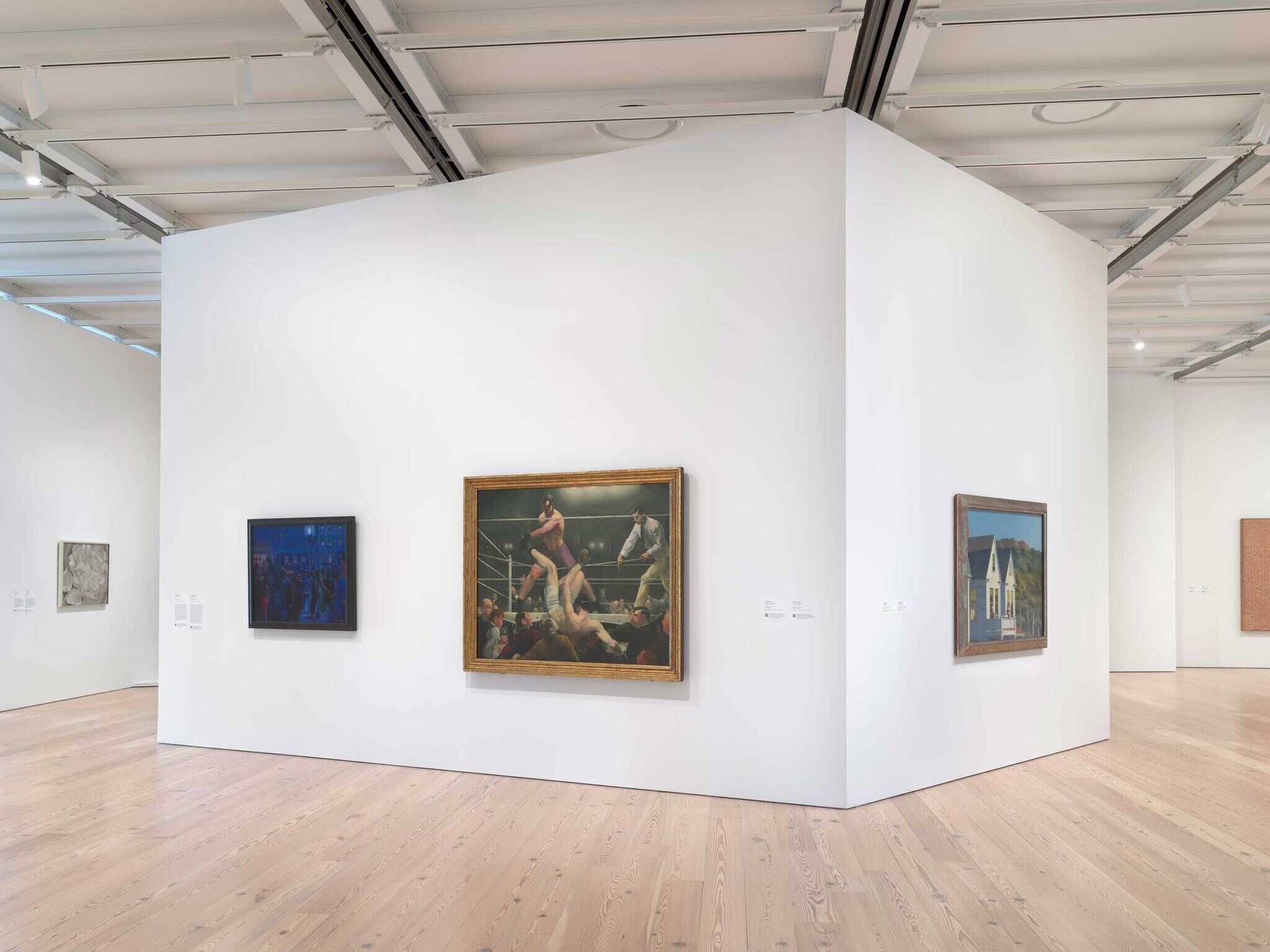

Installation view of “Untitled” (America) (Whitney Museum of American Art, New York, July 5, 2025-). From left to right: Georgia O’Keeffe, The White Calico Flower, 1931; Archibald John Motley Jr., Gettin’ Religion, 1948; George Bellows, Dempsey and Firpo, 1924; Edward Hopper, Second Story Sunlight, 1960; Yayoi Kusama, Air Mail Stickers, 1962. Photograph by Ron Amstutz
From the exhibition “Untitled” (America)

